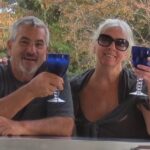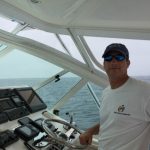Cummins Marine Diesel Repower Specialists › Forums › Cummins Marine Engines › Cummins QSC 8.3 Aftercoolers
- This topic has 39 replies, 8 voices, and was last updated 4 years ago by
 Stephen Oliver.
Stephen Oliver.
-
CreatorTopic
-
February 20, 2018 at 8:07 pm #28384
Bruce Van FleetParticipantHi everyone. I’ve been reading some great information on this forum regarding the recommended aftercooler maintenance procedures for the Cummins 8.3. During my boat survey today of a 2012 Sabre 48 with 1400 hours on the QSC 8.3 engines I was told by the broker he does not believe the aftercoolers on this boat have ever been serviced. Today’s survey was just what we could complete with boat out of the water. I have my engine survey scheduled to take place place in a few weeks once we can get the boat into water but wanted to ask here what people’s opinions would be regarding this lack of aftercooler care. Based on what I’ve read, I am fearful this may turn into some type of dealbreaker. Thank you for any thoughts that can help me evaluate my potential boat purchase.
-
CreatorTopic
-
AuthorReplies
-
August 25, 2018 at 2:43 pm #36409
bduniganParticipantTom:
I am just starting this process on a 13 Sabre 42.
Did you ever try the M4 props? Did they resolve your loading between 1600-2300 and reduce overall load? Could you have ‘rep itched’ the M series Zeus props?
May 9, 2018 at 8:59 am #32108
Tom BartolomeiParticipantVessel Name: Doghouse - 48' Sabre Salon Express
Engines: Twin QSC 8.3
Location: Seattle
Country: USA
The pitch difference between the M7 and M5 is a little over 2″ as I understand from Mercury. There are two props (counter rotating) per pod. The front prop is a five blade while the rear prop is a four blade. The pods also have an integrated trim tab system which automatically regulates the position of the trim tabs. I did all of these runs (except Sabre Hull #1 which is their first release of this vessel back in 2012) with the trim tab system on ‘auto’ but frankly am not impressed with the auto trim tab system. I have noticed that I can dial in better vessel performance with the tabs in manual mode. “Better performance” meaning lower fuel flow, lower load, and more comfortable ride/bow rise.
After a few calls, I may be able to try out a set of M4 props. These suckers are $1,900 per prop.
To Tony’s point on …”Engine achieves or exceeds rated rpm when accelerating from idle to full throttle”. So I can be sure I understand what this means in practice; do you guys recommend I do a run starting at say 800 RPM and push the throttles straight to the stops and monitor/log the RPMs generated as the vessel accelerates through to its top end? This would confirm what the graphs are indicating which is while the new prop (M7) has helped a bit on the top end, albeit still above target GPH, the more troubling area is cruise rpm where a still much lower pitch is warranted. If M7 to M5 was worth about 2″ of pitch and bought me 120 RPM on the top end, I’m thinking M4 (another 1″) won’t cut it.
The engines are really working in that 1600 to 2300 RPM range which is that point where the boat is trying to get on plane.
Tom
May 9, 2018 at 4:19 am #32094
Rob SchepisForum ModeratorVessel Name: Tenacious
Engines: 6BTA 5.9 330's - "Seaboard Style"
Location: Long Island, NY
Country: USA
Nice graph Tom. So your M7 prop runs were not fully loaded as was your M5 run but the curves stayed very close although the M5’s picked you up some top end rpm. So basically, as to cruise, your new props let you run fully loaded right where you were with the prior props at lighter loads..so still far above the target GPH.. Must be a tough boat to get on an efficient plane and something less than high speed…
May 8, 2018 at 9:29 pm #32088
Tom BartolomeiParticipantVessel Name: Doghouse - 48' Sabre Salon Express
Engines: Twin QSC 8.3
Location: Seattle
Country: USA
Thanks Tony –
There was a graph attached that included performance with the new props (M5 versus my original M7 props) but that graph is somehow missing now from my post. I’ve reattached it here.
I’m at 3020 now at WOT with the vessel and new props but not quite achieving that easily as you say and as I’d like. Clearly still working hard over the entire RPM range from say 1200+ RPM.
I may have a source to try out the next pitch size down on these Mercury Zeus props. They are not easy to come by to say the least.
Tom
May 8, 2018 at 8:39 pm #32086
Tony AthensModeratorVessel Name: Local Banks
Engines: QSB 6.7 550 HP
Location: Oxnard, CA
Country: USA
Make a graph with the new props……….Unless you make a solid 3070 or so RPM and make it EASY, I would say you are still not there an have a ways to so with a hull that operates like yours at its “working weight”.. ..
Graph attached.. But that is secondary to how your vessel seems to load the engine…………….. Did you or your prop guy READ and understand this requirement: • Engine achieves or exceeds rated rpm when accelerating from idle to full throttle
That’s is the key to what you are missing.. WOT RPM is not the issue, it’s what is happening at CRUISE RPM..
May 8, 2018 at 4:54 pm #32072
Tom BartolomeiParticipantVessel Name: Doghouse - 48' Sabre Salon Express
Engines: Twin QSC 8.3
Location: Seattle
Country: USA
Bruce –
Not sure you are still monitoring or not. Finally received new M5 prop sets and ran the tests. Attached graph updated. Getting 3020 at WOT now with vessel fully loaded. Compare that to the other runs where vessel wasn’t loaded quite the same (will do that in future though to really nail apples to apples). Somewhat puzzling in the ‘fat’ or off plane range where I see no difference between any configuration of boat loading or prop set. Maybe Tony or others can chime in. I start out close to the cummins curve then diverge from it quite a bit between 1600-2400 rpm then it gets a little better from then on up until finally converging at the WOT point.
I either run in the green zone or run in the blue zone. Makes sense, either on plane or at hull speed for this cruiser. Anything in the middle is really hard work. A break down of my load factor is below. I chart every trip and log the hours and the fuel burn. Also don’t tend to cruise at the high RPM with full fuel (520 gallons for my boat).
56% of overall hours with <15% load factor
27% of overall hours with 16% to 30% load factor
15% of overall hours with 31% to 45% load factor
2% of overall hours with 46% to 60% load factorHave 354 hours on this vessel and my average load factor is 17%.
Not sure I’m going to chase further prop changes at this point.
Tom
April 9, 2018 at 2:37 pm #30837
Tom BartolomeiParticipantVessel Name: Doghouse - 48' Sabre Salon Express
Engines: Twin QSC 8.3
Location: Seattle
Country: USA
Attachment…
April 9, 2018 at 9:41 am #30800
Tom BartolomeiParticipantVessel Name: Doghouse - 48' Sabre Salon Express
Engines: Twin QSC 8.3
Location: Seattle
Country: USA
Bruce – Attached is a graph of my vessel’s performance compared to Cummins Spec and Sabre’s own Hull #1. The props on my boat are M7’s as I mentioned above. The props on Sabre’s Hull #1 also M7.
Sabre Hull #1: 100% Fuel, 100% water, 6 adults, 0% waste, clean bottom, no dingy
My Vessel Loading: 50% fuel, 75%, water, 50% waste, 2 adults, tools & rations, 12 months on the bottom, Dingy on freedom lift (800 lbs dingy only). Freedom lift weight not known but significant.You can see how much harder my engines are working with these props across the RPM range. New props arrived finally (they are hard to source) and boat is being hauled tomorrow. Should have her back in the water next week and will add a 5th line on the chart for the vessel performance with M5 props. I didn’t breakout fuel flow between engines as they were within 1 gph of each other at each setting. WOT performance on mine for each run was 2900, 60 GPH, and 100% eng load.
Tom
April 8, 2018 at 7:42 pm #30793
Bruce Van FleetParticipantHi Phil,
I was under the impression that the Cummins computer being hooked up during our run was going to track fuel burn but it did not. I do know we hit max rpm of 2950 port and 2960 stbd with full fuel and 7 guys on board, displayed a combined fuel burn of 59.6 GPH.
And great to know that seaboard will service the new aftercoolers before shipping but I’m just not sure I’d be able to convince them to order them from someone other than their usual source. I do want to tell them what I want done them before installing. Or at least the chance to it do myself.April 8, 2018 at 6:50 pm #30790
PhilipParticipantVessel Name: 2007 35’ Cabo ‘FUGA’
Engines: Cummins QSC8.3-540’s
Location: Long Beach, CA
Good info… any chance you got some fuel burn numbers and some pictures?
To answer your questions, 1. no, 2. Yes
New aftercooler already come services from Seaboard, just FYI
Phil
April 8, 2018 at 6:11 pm #30786
Bruce Van FleetParticipantGood evening,
Got through a succesfull sea trial on the Sabre 48 with Cummins QSC 8.3 engines. As mentioned, 2012 aftercoolers never before serviced. Although temps were all ok, we were given an allowance to replace aftercoolers with new ones. I want to open the new ones up and Alco Metalube them the Seaboard way before they get put on. Two questions…1. Do I still install NEW o rings before re-assembly even though aftercoolers are brand new? 2. Should aftercoolers be pressure tested after reassembly or is this not required on brand new ones? Thanks again for the anticipated assistance. What a great resource! Hopefully someday soon I’ll have the added knowledge to pay it forward!March 20, 2018 at 4:37 pm #29725
Bruce Van FleetParticipantThanks for the additional info Tom. I’m interested to hear about your results with the prop change. Weather up here has delayed things for me a little bit. My sea trial was moved to next week. I’ll be sure to note rpms to determine if this one is over propped too.
March 15, 2018 at 10:29 am #29505
Tom BartolomeiParticipantVessel Name: Doghouse - 48' Sabre Salon Express
Engines: Twin QSC 8.3
Location: Seattle
Country: USA
Bruce –
Not sure where you are in the process of looking at that Sabre 48. I am due to receive new props on mine in a couple weeks. I dropped from my current M7’s down to M5’s. I need a good 200 RPM at WOT. Will get her on out and test with the new props and report results here.
Tom
February 27, 2018 at 9:56 pm #28646
Tom BartolomeiParticipantVessel Name: Doghouse - 48' Sabre Salon Express
Engines: Twin QSC 8.3
Location: Seattle
Country: USA
Bruce-
I have the same 48 Sabre with the same engines, although mine is a 2014 with 150 hours on her last year Feb when I bought it. 330 on the clock now. Had a prior searay(390DA with QSB’s) and set her up with many if not all of the recommendations on this site. That paid off in performance and re-sale value.
On the Sabre, I also have a 800# dinghy on the back. I’m coming up short on WOT RPM’s fully loaded and am in the process of dropping pitch. Zeus pods and the prop sets are a bit more unique than conventional straight shaft or v drive set ups. I suspect you have the M7 prop sets. I’m 200RPM short of where I want to be and dropping to M5 prop sets. I wouldn’t be surprised if you’re short on rpm as well and may be looking at M6 or M5. Sabre itself makes a great boat and you won’t be disapppointed. Engine maintenance and pod maintenance is what it’s all about. Your riser set up is fine. Do get those aftercoolers off and serviced and fill out the info requested above but again, I won’t be surprised if you are short on RPM fully loaded.
I also replaced pod hydraulic filters…again, a bit unique compared to conventional setups but so far I’m happy with the vessel and power/drive train.
This vessel of mine was from Newport Beach CA. I pulled the aftercoolers and all was well with them. I wouldn’t get hung up on oil analyses unless you have a trend showing something off.
Happy to help where I can on this specific boat configuration.
Tom
1 user thanked author for this post.
February 25, 2018 at 5:08 pm #28537
Bruce Van FleetParticipantI will be sure to complete the fuel burn chart on the sea trial and post here for you thoughts.
And thank you Rob and Philip for taking the time to provide some helpful info!February 25, 2018 at 7:56 am #28517
Rob SchepisForum ModeratorVessel Name: Tenacious
Engines: 6BTA 5.9 330's - "Seaboard Style"
Location: Long Island, NY
Country: USA
Bruce,
I attach:
– Port Engine Dataplate
– Starboard Engine Dataplate
– Performance Curve
– Fuel Burn Chart To Be CompletedOn the next sea trail fill in the right hand column I added to this chart at the listed rpms and that will tell you how she is propped, especially important at the intended cruise rpm’s, and this will tell if she’s been working too hard to date..
Keep in mind that the items you are concerning yourself with will likely be issues to some extent on every boat you look at. So you could easily burn a lot of time and a lot of $$$ trying to find what does not exist. My take on boat shopping is if the boat itself is the right boat, the deal is fairly convenient and things “generally” check out okay, it all comes down to getting it at a price that works for you and use that time and money you saved to make things 100% right once she becomes yours….. Because that is the only way you will sleep at night and be 100% comfortable that you are setup properly for long term success…
February 23, 2018 at 12:17 pm #28486
PhilipParticipantVessel Name: 2007 35’ Cabo ‘FUGA’
Engines: Cummins QSC8.3-540’s
Location: Long Beach, CA
Bruce…
Your pictures are not the best, very grainy and not enough angles to comment more than yes there appears to be some blooming on the aftercooler end caps. Not bad but until they come apart there is not much else to go on.
I was suggesting that simply being Cummins certified doesn’t guarantee they know how to PROPERLY service the aftercooler for long term service. Read the article I attached and compare how they service vs the article. If it’s the same then your dealing with someone that will set you up for long term success.
You don’t appear to have the fuel cooler and I don’t see the gear cooler but it’s got to be someplace. If all is serviceable my guess would be $7000 to do all properly (remove all from engines, take to shop, service, test, reinstall). If the aftercooler is not serviceable it’s $3200 a piece plus the labor. And even a factory new aftercooler needs to be disassembled and greased as stated in the article on how to service.
Oil analysis usually causes more questions than answers and in the absence of long term regular samples that can establish a real trend mean very little. A much better indicator of engine health is:
– how easy they start from stone cold – should start with a few revolutions
– how much smoke on start up if any – less to none is best
– how they idle
– fuel burn/rpm vs spec
– max rpmHopefully someone will post up the fuel burn/rpm chart for you.
Overall the QSC is an awesome engine and proven design and reliability. Take care of it and it will take care of you.
2 users thanked author for this post.
February 22, 2018 at 8:54 pm #28458
Bruce Van FleetParticipantThank you for your input Philip. To answer your questions, yes the boat is used in salt water and there is no fresh water flush installed. Port engine serial number is 73280826. Starboard engine serial number is 73279680. Engine model is QSC 550 HO P, CPL090600. I have attached what few pictures I have. As you can see, there is in fact the “blooming” as you called it from the end cap seem. My engine survey IS being done by Cummins NE out of Scarborough. ME. Are you suggesting you would not rely on their evaluations? If so, what do you estimate the cost to be if in a worst case scenario if both engines required the replacement of seawater pump, fuel/oil cooler, aftercooler, and heat exchanger. I agree, this may need to be factored into the purchase price. I am having the oil analysis done but wonder how worthwhile it will be since the oil was changed in November prior to layup. If there was salt water that got past the aftercoolers what other signs would there be? Also, would you be able to provide the RPM and Fuel burn info you had mentioned earlier?
Thank you very much for your thoughts. I am very grateful for the help.February 20, 2018 at 11:47 pm #28386
PhilipParticipantVessel Name: 2007 35’ Cabo ‘FUGA’
Engines: Cummins QSC8.3-540’s
Location: Long Beach, CA
Bruce –
You leave a few details out such as was the boat used in fresh or saltwater? If salt, is a fresh water flush installed. Post a few pictures of the entire engine from all angles and some close up of the aftercooler and end caps. Are there any signs the cooler has been apart? Is there salt crust blooming from the end cap seams?
Having said that, your engine surveyor should be able to answer some of these questions IF and only IF they understand how to service Cummins aftercooler. Not a Cummins certified mechanic but any mechanic who can describe to you how they would expect a cooler to be serviced. Below is an article that you should use for your comparison.
Your liability here is not just the aftercooler (which are $3200 a piece) but in the absence of service records/history the entire cooling system needs a close look and service of the following: seawater pump, fuel/oil cooler, aftercooler, and heat exchanger.
Other items to pay attention to or have your surveyor inspect and comment on are:
1. Alternator output – voltage should increase when engine starts, measure at back of alternator with a volt meter. Also if you can remove belt and spin it to verify bearings are smooth
2. Belt condition – visual
3. Idler pulley condition – if you can remove belt and spin idler pulleys to confirm they are smooth and no wobble.
4. Coolant pump – if you can remove belt spin the coolant pump for smooth bearings and no wobble
5. Tensioner pulley – smooth and wobble free.The above list are all items that if they fail can overheat an engine quickly and cause damage.
Finally would be exhaust design and turbo condition. A few pictures of the turbo and exhaust will allow us to comment on design liability.
Post the exact engine model and serial/cpl. that will allow us to get you the proper rpm/fuel burn info so when you do a sea trial you can compare fuel burns and see if the engine has been overloaded or will need prop adjustments.
And even if items need to be addressed, knowledge and factoring in these items into the sales price if the deal makes sense and cents then it will all work out. If not then you didn’t want it anyways.
Phil
-
AuthorReplies
You must be logged in to reply to this topic.
